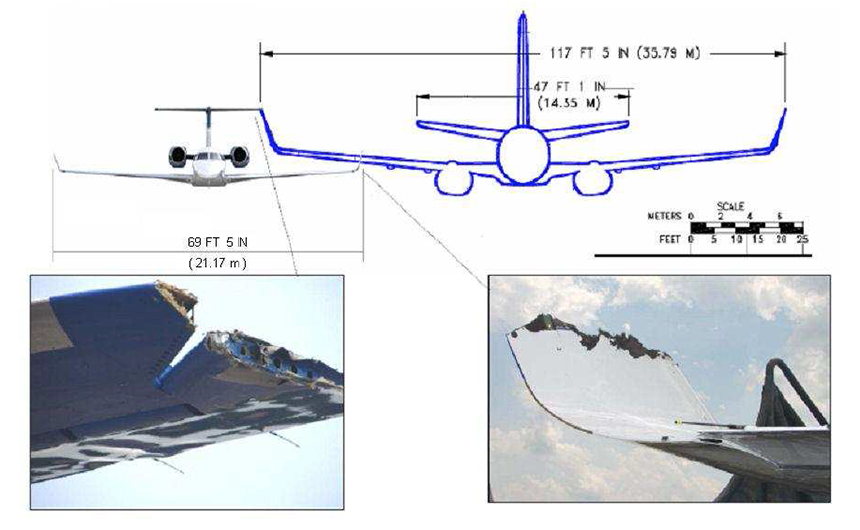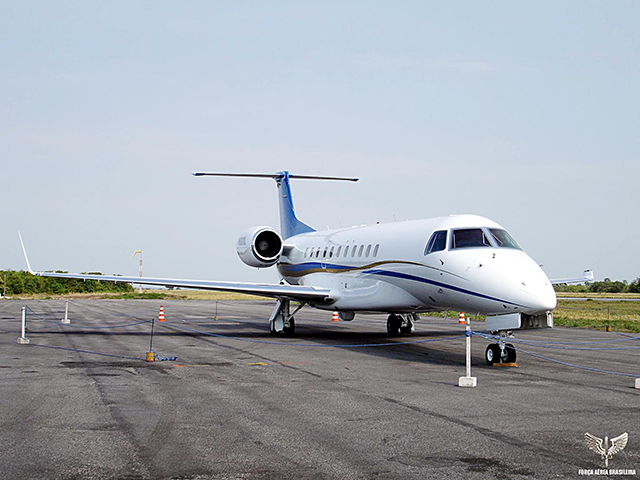There is no doubt that the air traffic control system let everyone involved down in the events leading to this mishap. But there should also be no doubt that the pilots of N600XL could have prevented the midair had they understood and followed ICAO lost communications procedures. Were these bad pilots? No, not at all. These were pilots that had not been properly trained for the rigors of international flying. But it isn't as cut and dried as many think.
— James Albright

Updated:
2014-04-24
We don't often have to think about lost communications and when it actually happens we are not "spring loaded" to pulling up ICAO Annex 2 and digging up our filed flight plan. Perhaps the best lesson from this mishap is that if we ever go more than a few minutes without radio contact, we need to get paranoid.
Specifically, about this midair, the Boeing 737 was at the altitude it was supposed to be at, the Embraer was not. Lost on many U.S. pilots when discussing this incident is the fact United States FAA lost communications are an exception to ICAO lost communications procedures. You should not venture outside U.S. airspace until you understand the differences. The bottom line is that the Big Sky Theory doesn't work.

1
Accident report
First Aircraft:
- Date: 29 SEP 2006
- Time: 16:57
- Type: Embraer EMB-135BJ Legacy 60
- Operator: ExcelAire
- Registration: N600XL
- Fatalities: 0 of 2 crew, 0 of 5 passengers
- Aircraft Fate: Repaired
- Phase: En route
- Airports: (Departure) São José dos Campos Airport, SP (SJK) (SJK/SBSJ), Brazil; (Destination) Manaus-Eduardo Gomes International Airport, AM (MAO) (MAO/SBEG), Brazil
Second Aircraft:
- Type: Boeing 737-8EH
- Operator: Gol Transportes Aéreos
- Registration: PR-GTD
- Fatalities: 6 of 6 crew, 154 of 154 passengers
- Aircraft Fate: Destroyed
- Phase: En route
- Airports: (Departure) Manaus-Eduardo Gomes International Airport, AM (MAO/SBEG), Brazil; (Destination) Brasília-Presidente Juscelino Kubitschek International Airport, DF (BSB/SBBR), Brazil
2
Narrative
On September 29, an Embraer Legacy 600 executive jet (N600XL) was scheduled to be delivered from the Embraer factory at São José dos Campos Airport (SJK) to the United States. An intermediate stop was planned at Manaus (MAO). The Legacy took off at about 14:51. The filed flight plan included a routing via the OREN departure procedure to Pocos beacon, then airway UW2 to Brasilia VOR (BRS), airway UZ6 to Manaus. The cruise altitude was filed as FL 370, with a planned change to FL 360 at BRS, and to FL 380 at the TERES navigational fix, approximately 282 miles north of BRS.
Meanwhile, at 15:35, GOL Flight 1907, a Boeing 737-800, departed Manaus (MAO) on a scheduled flight to Brasilia (BSB) and Rio de Janeiro (GIG). The flight was also routed via UZ6 to BRS. Cruising altitude was FL 370, which was reached at 15:58. At that time, Legacy N600XL had just passed BRS, level at FL 370. There is no record of a request from N600XL to the control agencies to conduct a change of altitude after passing BRS. There is also no record of any instruction from air traffic controllers at Brasilia Center to the aircraft, directing a change of altitude. When the airplane was about 30 miles north-northwest of BRS, at 16:02, the transponder of N600XL was no longer being received by ATC radar. Between 15:51 and 16:26, there were no attempts to establish radio communications from either the crew of N600XL or ATC. At 16:26 the CINDACTA 1 controller made a "blind call" to N600XL. Subsequently until 16:53, the controller made an additional 6 radio calls attempting to establish contact. The 16:53 call instructed the crew to change to frequencies 123.32 or 126.45. No replies were received. Beginning at 16:48, the crew of N600XL made a series of 12 radio calls to ATC attempting to make contact. They heard the 16:48 call, but the pilot did not understand all of the digits, and requested a repeat. No reply from ATC was received. The pilot made 7 more attempts to establish contact.
Both the GOL Boeing 737 and the Legacy were now on a head on collision course on airway UZ6 at the same altitude. Because the transponder of N600XL was not functioning properly -for as of yet undetermined reasons- the TCAS equipment on both planes did not alert the crews. At FL 370, over the remote Amazon jungle, both aircraft collided. The left winglet of the Legacy (which includes a metal spar) contacted the left wing leading edge of the Boeing 737. The impact resulted in damage to a major portion of the left wing structure and lower skin, ultimately rendering the 737 uncontrollable. The Boeing 737 was destroyed by in-flight breakup and impact forces.
The Embraer's winglet was sheared off and damage was sustained to the vertical stabilizer tip. The crew made numerous further calls to ATC declaring an emergency and their intent to make a landing at the Cachimbo air base. At 17:02, the transponder returns from N600XL were received by ATC. At 17:13, an uninvolved flight crew assisted in relaying communications between N600XL and ATC until the airplane established communication with Cachimbo tower.
A safe emergency landing was made.
3
Analysis
According to the Legacy's flight plan, the aircraft's initial cruise altitude was filed as FL 370, with a planned change to FL 360 at BRS, and to FL 380 at the TERES navigational fix, approximately 282 miles north of BRS. The descent to FL 360 after passing BRS was because the magnetic course of airway UW2 inbound to BRS was 006 degrees and the magnetic course of airway UZ6 outbound from BRS was 336 degrees.
- 19:23:29 UTC — The Legacy was instructed to monitor 123.75. They may have been on the wrong frequency since the previous controller didn't instruct them to change to a closer sector. This was the last two-way communication.
- 19:36:48 UTC — The Legacy passed position TERES and maintained FL 370. Had they had radio contact they would have been told to climb to FL 380. Although it had been 13 minutes the crew did not appear aware they had a communications problem at this point. Pilots with more South America experience may have realized there was a problem when they didn't get the level change and would have begun trying to establish radio contact at this point and possibly squawk 7600. This would have also alerted them to the fact their transponder had somehow switched to standby which also removed their TCAS capability.
- 19:48:51 UTC — The Legacy SIC began a series of attempts to establish radio contact.
- 19:53:30 UTC — The Legacy SIC heard an air traffic control broadcasted in the blind but did not copy the transmitted frequency.
- 19:56:54 UTC — The midair occurred.
The Legacy crew may have been trapped by the thought that radio contact would happen momentarily or that remaining at their current flight level was the right thing to do in any case. But I hope that a properly trained international pilot would have reacted thusly:
- Once they passed position TERES they should have realized not getting a level change meant something was amiss and they should have started trying to reestablish radio contact while also squawking 7600.
- Seven minutes later they should have climbed to FL 380 as was recorded in their filed flight plan. Had they done this the midair would not have occurred.
Under U.S. Federal Aviation Regulations (14 CFR § 91.185), aircraft experiencing two-way radio communications failure are to fly the highest of three possible flight levels: the level assigned in the last ATC clearance received, the minimum level for instrument operations, or the level ATC has advised may be expected in a further clearance. Using this guidance, it's understandable why the Legacy crew stayed at FL 370 contrary to the hemispheric rule and the filed flight plan.
In contrast:
. . . that in the event of communications failure in IMC:
In airspace where radar is used in the provision of air traffic control, maintain the last assigned speed and level, or minimum flight altitude if higher, for a period of 7 minutes following:
- the time the last assigned level or minimum flight altitude is reached; or
- the time the transponder is set to Code 7600; or
- the aircraft's failure to report its position over a compulsory reporting point;
whichever is later, and thereafter adjust level and speed in accordance with the filed flight plan;
Source: ICAO Annex 2, ¶3.6.5.2.2. b)
We can only guess the number of pilots over the years who have reacted exactly as the crew of N600XL to no ill effect. In all those cases, as far as we know, there wasn't another airplane competing for the same space. This Legacy crew was not so lucky. I feel for these pilots and hope we can all learn from their misfortune.
My take on this: our duty as pilots is to keep the airplane where it is supposed to be and if there is any doubt, we fall back on what everyone else is expecting. Air traffic control expected them to adjust level and other airplanes were depending on it.
The Brasil Command of Aeronautics Final Report is very thorough but appears to be dancing a fine political line between getting it right and not angering the U.S. Government. They do make note of the fact the Embraer pilots were not ready for the challenge of international flight. (I agree.) The U.S., for its part, says there is no evidence of that, but goes on to say on page 8 of its comments: "Nevertheless, during the course of the investigation, it became clear to the U.S. team that training for international operations may be insufficient for certain operations."
Flying in Brasil today is much easier than it used to be. Before this mishap, I remember having to use Broadcast in the Blind procedures and worrying incessantly about other airplanes invading my space. After the mishap I was pleasantly surprised by the rapid response from all Brasil air traffic controllers and the frequent issuing of back up frequencies. But the lesson remains: when venturing outside U.S. airspace, U.S. pilots need to understand ICAO lost communications procedures.
4
Cause
"The evidence collected during this investigation strongly supports the conclusion that this accident was caused by N600XL and GLO1907 following ATC clearances which directed them to operate in opposite directions on the same airway at the same altitude resulting in a midair collision.
The loss of effective air traffic control was not the result of a single error, but of a combination of numerous individual and institutional ATC factors, which reflected systemic shortcomings in emphasis on positive air traffic control concepts.
Contributing to this accident was the undetected loss of functionality of the airborne collision avoidance system technology as a result of the inadvertent inactivation of the transponder on board N600XL.
Further contributing to the accident was inadequate communication between ATC and the N600XL flight crew."
References
(Source material)
(Brasil) Command of Aeronautics, Aeronautical Accident Investigation and Prevention Center, Final Report A-00X/CENIPA/2008, PR-GD and N600XL, B-737 9EH and EMB-135 BJ Legacy, 29 September 2006
ICAO Annex 2 - Rules of the Air, International Standards, Annex 2 to the Convention on International Civil Aviation, July 2005


